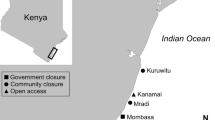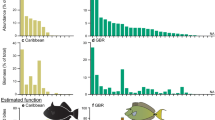Abstract
Intensive fishing can cause dramatic, long-lasting shifts in benthic habitat. This study used three approaches to test whether overharvesting of blacklip abalone (Haliotis rubra) can cause a shift in benthic habitat to a configuration that is unsuitable for abalone, on the east coast of Tasmania, Australia. After 18 months of removing abalone from rocks, encrusting red algae (ERA) became overgrown by filamentous and foliose algae, sessile invertebrates and accumulated sediment. The differences in the community composition between locations, sites nested within locations and rocks were minor. Throughout the study, abalone were largely associated with areas of rock covered in ERA but avoided other habitats. A transplant experiment demonstrated that abalone preferred areas of rock covered in ERA but move away from overgrown rocks. These results suggest overharvesting of abalone results in a shift to benthic habitat poorly preferred by abalone. This could form a positive feedback loop that limits recovery of abalone populations and ERA.





Similar content being viewed by others
References
Anderson MJ, Gorley RN, Clarke KR (2008) PERMOVA+ for primer: guide to software and statistical methods, 1st edn. PRIMER-E, Plymouth
Chapman ARO, Johnson CR (1990) Disturbance and organization of macroalgal assemblages in the Northwest Atlantic. Hydrobiologia 192(1):77–121
Clarke KR, Warwick RM (2001) Change in marine communities: an approach to statistical analysis and interpretation, 2nd edn. PRIMER-E, Plymouth
Connell SD (2003) The monopolization of understorey habitat by subtidal encrusting coralline algae: a test of the combined effects of canopy mediated light and sedimentation. Mar Biol 142:1065–1071
Daume S, Brand S, Woelkerling WJ (1997) Effects of post-larval abalone (Haliotis rubra) grazing on the epiphytic diatom assemblage of coralline red alga. Moll Res 18:119–130
Daume S, Brand-Gardner S, Woelkerling WJ (1999) Preferential settlement of abalone larva: diatom films versus non-geniculate coralline red algae. Aquaculture 174:243–254
Day E, Branch GM (2000) Evidence for a positive relationship between juvenile abalone Haliotis midae and the sea urchin Parechinus angulosus in the South Western Cape, South Africa. SA J Mar Sci 22:145–156
Edgar GJ, Barrett NS (1999) Effects of the declaration of marine reserves on Tasmanian reef fishes, invertebrates and plants. J Exp Mar Biol Ecol 242(1):107–144
Huggett MJ, de Nys R, Williamson JE, Heason M (2005) Settlement of larval blacklip abalone Haliotis rubra, in response to green and red macroalgae. Mar Biol 147(5):1432–1793
Jackson JBC, Kirby MX, Berger WH, Bjorndal KA, Botsford LW, Bourque BJ, Bradbury RH, Cooke R, Erlandson J, Estes JA, Hughes TP, Kidwell S, Lange CB, Lenihan HS, Pandolfi JM, Peterson CH, Steneck RS, Tegner MJ, Warner RR (2001) Historical overfishing and the recent collapse of coastal ecosystems. Proc Natl Acad Sci USA 293(5530):629–637
Jenkins GP (2004) The ecosystems effects of fishing abalone: a review. Mar Freshw Res 55(6):545–552
Kitting CL (1997) Feeding effects of post larval red abalone, Haliotis rufescens (Mollusca: Gastropoda) on encrusting coralline algae. Moll Res 18:183–196
Lessard J, Campbell A (2007) Describing northern abalone, Haliotis kamtschatkana, habitat: focusing rebuilding efforts in British Columbia. Can J Shell Res 26(3):677–686
Ling SD (2008) Range-expansion of a habitat-modifying species leads to loss of taxonomic diversity: a new and impoverished reef state. Oecologia 156:883–894
Ling SD, Johnson CR, Frusher SD, Ridgway KR (2009) Overfishing reduces resilience of kelp beds to climate-driven catastrophic phase shift. Proc Roy Acad Sci 106(52):22341–22345
Marzloff MP, Dambacher JM, Johnson CR, Little RL, Frusher SD (2011) Exploring alternative states in ecological systems with a qualitative analysis of community feedback. Ecol Model 222(15):2651–2662
Miller KJ, Maynard C, Mundy CN (2008) Genetic diversity and gene flow in collapsed and healthy abalone fisheries. Mol Ecol 18:200–211
Miner CM, Altsrarr JM, Raimondi PT, Minchinton TE (2006) Recruitment failure following and shifts in community structure following mass mortality limit recovery prospects of black abalone. Mar Ecol Prog Ser 327:107–117
Morgan LE, Shepherd SA (2006) Population and spatial structure of two common temperate reef herbivores: abalone and sea urchins. In: Kritzer JP, Sale PF (eds) Marine metapopulations. Elsevier Academic Press, USA, pp 205–246
Morse ANC, Morse DE (1984) Recruitment and metamorphosis of Haliotis larvae induced by molecules uniquely available at the surfaces of crustose red algae. J Exp Mar Biol Ecol 75(3):191–215
Mumby PJ, Hastings A, Edwards HJ (2007) Thresholds and the resilience of Caribbean coral reefs. Nature 450:98–101
Pederson HG, Barrett ND, Frusher SD, Buxton CD (2008) Effect of predator-prey and competitive interactions on size at emergence in the black-lip abalone Haliotis rubra in a Tasmania MPA. Mar Ecol Prog Ser 366:91–98
Prince J (1989) The fisheries biology of the Tasmanian stocks of Haliotis rubra. PhD thesis, University of Tasmania, Hobart, Australia
R Development Core Team (2010) R: a language and environment for statistical computing. R project for statistical computing, Vienna, Austria. http://www.R-project.org
Scheibling RE (1994) Molluscan grazing and macroalgal zonation on rocky intertidal platform at Perth, Western Australia. Aust J Ecol 19:141–149
Shepherd SA (1973) Studies on southern Australian abalone (genus Haliotis). I. The ecology of five sympatric species. Mar Freshw Res 24:217–257
Shepherd SA, Turner JA (1985) Studies on southern Australian abalone (genus Haliotis). VI. Habitat preference, abundance and predators of juveniles. J Exp Mar Biol Ecol 93(3):285–298
Sokal RR, Rohlf FJ (1995) Biometry: the principles and practice of statistics in biological research, 3rd edn. W.H. Freeman and Co., New York
Steneck RA, Watling L (1982) Feeding capabilities and limitation of herbivorous mollusks: a functional group approach. Mar Biol 68(3):299–319
Steneck RS, Graham MH, Bourque BJ, Corbett D, Erlandson JM, Estes JA, Tegner MJ (2002) Kelp forest ecosystems: biodiversity, stability, resilience and future. Environ Conserv 29:439–459
Strain EMA, Johnson CR (2010) Scale-dependent relationships between benthic habitat characteristics and abundances of blacklip abalone, Haliotis rubra (Leach). Mar Freshw Res 61:1227–1236
Tarbath DB, Gardener C (2010) Tasmanian abalone fishery 2009. Fishery assessment report. Tasmanian Aquaculture and Fisheries Institute, Hobart
Tegner MJ, Dayton PK (1999) Ecosystem effects of fishing. Trends Ecol Evol 14(7):261–262
Todd CD, Keough MJ (1994) Larval settlement in hard substratum epifaunal assemblages: a manipulative field study of the effects of substratum filming and the presence of incumbents. J Exp Mar Biol Ecol 181:159–187
Tutschulte TC, Connell JH (1988) Feeding behaviour and algal food of three species of abalone (Haliotis) in southern California. Mar Ecol Prog Ser 49:57–64
Valentine JP, Johnson CR (2003) Establishment of the introduced kelp Undaria pinnatifida in Tasmania depends on disturbance to native algal assemblages. J Exp Mar Biol Ecol 295(1):63–90
Valentine JP, Tarbath D, Frusher SD, Mundy CN, Buxton CN (2010) Limited evidence for ecosystems-level change on reefs exposed to Haliotis rubra (“blacklip abalone”) exploitation. Aust Ecol 35:1–13
Acknowledgments
We thank those who assisted with fieldwork, particularly Ryan Downie, Richard Holmes and David Sinn. This study was part of a Commonwealth Scientific and Industrial Research Organization Joint PhD Program in Quantitative Marine Science and supported by an Australian Postgraduate Award. The research was supported by Tasmanian Aquaculture and Fisheries Institute and Tasmanian Abalone Council grants. We thank the individuals from these organizations that participated in collecting the data. We thank the editor and two anonymous referees for their valuable comments to the manuscript and their constructive suggestions.
Author information
Authors and Affiliations
Corresponding author
Additional information
Communicated by M. A. Peck.
An erratum to this article can be found at http://dx.doi.org/10.1007/s00227-011-1859-4.
Electronic supplementary material
Below is the link to the electronic supplementary material.
227_2011_1833_MOESM1_ESM.pdf
Appendix A. Mean cover (±SE) of (i) encrusting red algae (ERA), (ii) filamentous algae, (iii) the sediment matrix and (iv) sessile invertebrates on areas under abalone and other positions on the rocks through time (months) at the Jetty and Magistrates Point, Maria Island in the removal experiment. Treatments (n = 5) are solid triangles = 0% removals of H. rubra from rocks, and open triangles = 100% removal of H. rubra from rocks. (PDF 77 kb)
227_2011_1833_MOESM2_ESM.pdf
Appendix B. Mean cover (±SE) of (i) foliose green algae, (ii) foliose red algae, (iii) foliose understorey brown algae and (iv) juvenile canopy-forming algae on areas under abalone and other positions on the rocks through time (months) at the Jetty and Magistrates Point, Maria Island in the removal experiment. Treatments (n = 5) are solid triangles = 0% removals of H. rubra from rocks, and open triangles = 100% removal of H. rubra from rocks. (PDF 78 kb)
227_2011_1833_MOESM3_ESM.pdf
Appendix C. Mean cover (±SE) of (i) encrusting red algae (ERA) and (ii) filamentous algae (iii) sediment matrix (iv) sessile invertebrates A. under abalone, Southwest, B. under abalone Southeast, C. other positions Southwest, D. other positions Southeast through time (months) at George Third Rock, in the removal experiment. Treatments (n = 3) are: solid triangles = 0% removals of H. rubra from unfenced rocks; open triangles = 100% removal of H. rubra from unfenced rocks; solid squares = 0% removals of H. rubra from partially fenced rocks; open squares = 100% removals of H. rubra from fenced rocks. (PDF 114 kb)
227_2011_1833_MOESM4_ESM.pdf
Appendix D. Mean cover (±SE) of (i) foliose red algae, (ii) foliose understorey brown algae and (iii) juvenile canopy-forming algae A. under abalone, Southwest, B. under abalone Southeast, C. other positions Southwest, D. other positions Southeast through time (months) at George Third Rock, in the removal experiment. Treatments (n = 3) are: solid triangles = 0% removals of H. rubra from unfenced rocks; open triangles = 100% removal of H. rubra from unfenced rocks; solid squares = 0% removals of H. rubra from partially fenced rocks; open squares = 100% removals of H. rubra from fenced rocks (PDF 80 kb)
227_2011_1833_MOESM5_ESM.docx
Appendix E. Benthic assemblage at a) Maria Island (MI) prior to experimental manipulations, 0 months, b) MI, after 18 months of removing Haliotis rubra from rocks, c) George Third Rock (GIII) prior to experimental manipulations, 0 months and d) GIII, after 18 months of removing H. rubra from rocks. (DOCX 441 kb)
Rights and permissions
About this article
Cite this article
Strain, E.M.A., Johnson, C.R. Intensive fishing of marine consumers causes a dramatic shift in the benthic habitat on temperate rocky reefs. Mar Biol 159, 533–547 (2012). https://doi.org/10.1007/s00227-011-1833-1
Received:
Accepted:
Published:
Issue Date:
DOI: https://doi.org/10.1007/s00227-011-1833-1




